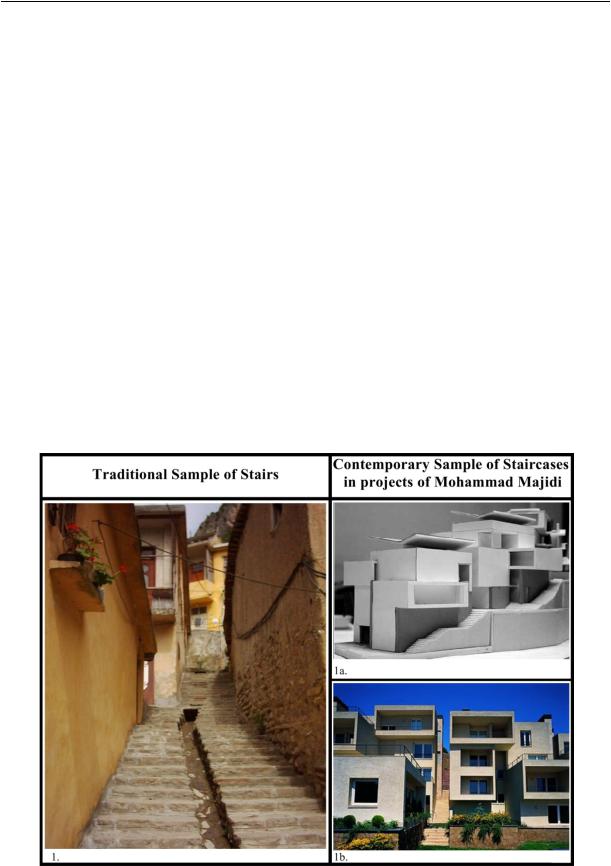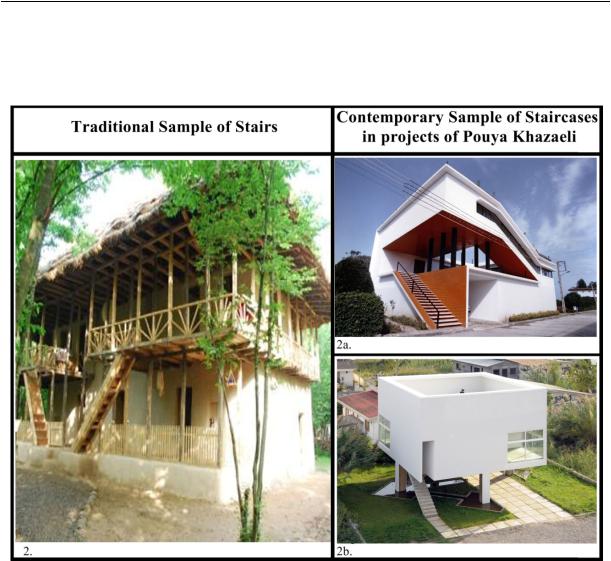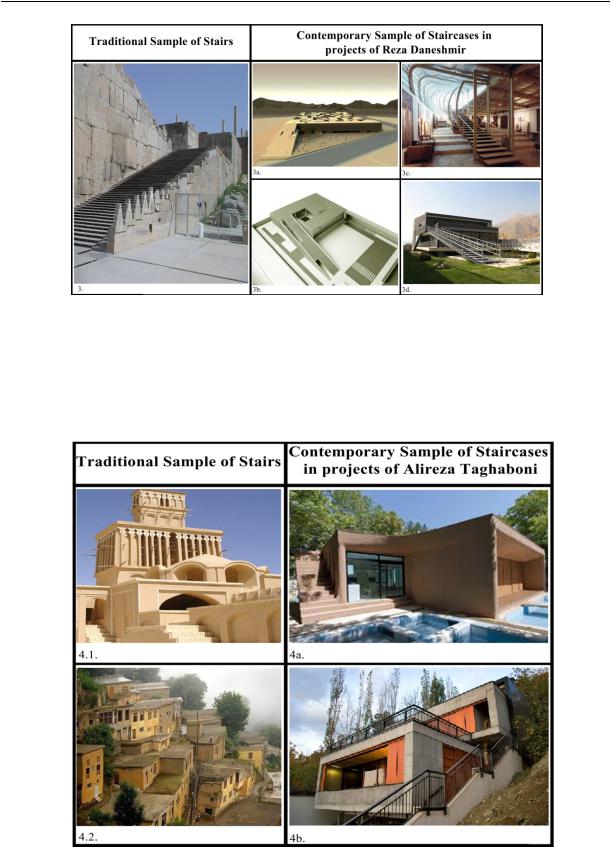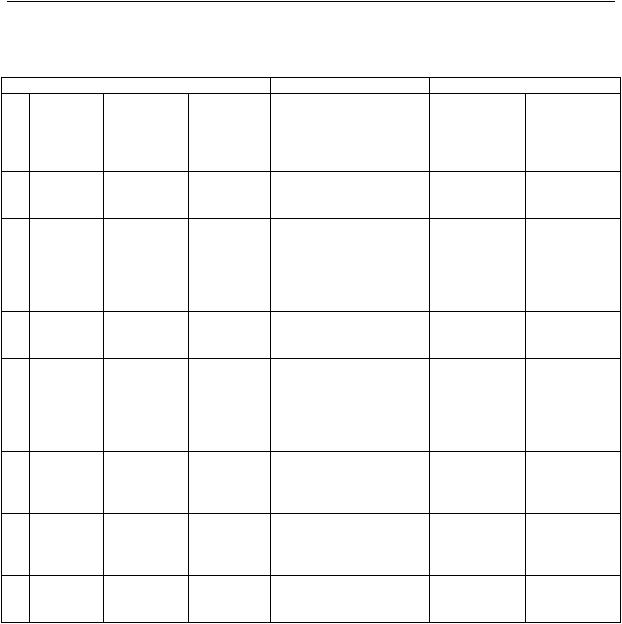
3553
.pdf
Issue № 1(33), 2017 |
ISSN 2542-0526 |
ARCHITECTURE OF BUILDINGS AND STRUCTURES.
CREATIVE CONCEPTIONS OF ARCHITECTURAL ACTIVITY
UDC 721
Ghazal Farjami1,Yonca Hurol2
TIME CONCEPTS IN RELATION TO COLLABORATION BETWEEN ARCHITECTSAND STRUCTURALENGINEERS – EXEMPLIFIED BYPARTICULAR STAIR DESIGNS IN IRAN
Alanya HEP University
Turkey, Alanya/Antalya, tel.: + 98 913 117 3625, e-mail: ghazal.farjami@gmail.com 1Assist. Professor, Department of Architecture
Eastern Mediterranean University
North Cyprus, tel.: + 90 392 630 2047, e-mail: yonca.al@emu.edu.tr 2Professor, Department of Architecture
Statement of the problem. There is a difference between many professions’ self-conceptions and their actual practices. Collaborating with other professions, this ideological deviation negatively affects the collaboration between different professions. This article is an attempt to examine the self-conceptions and actual practices of architects and structural engineers in Iran to make suggestions for better collaboration between these two professions. The self-conceptions of both architects and structural engineers are related to time concerns in different ways. However, in terms of the time concerns of actual building practices, both professions differ from their self-conceptions. Results. Therefore, this article argues that the mismatch between self-conception and actual practice is problematic. To present this mismatch, the article provides the necessary theoretical framework and analyses the time concepts of ten stair designs in Iran from architectural and structural engineering perspectives.
Conclusions. These ten stairs are selected from the architectural projects of four contemporary Iranian architects, who do their best to consider time to achieve authenticity in their architectural works. Moreover, the structural engineering approach to time was analysed through literature and interviews with structural engineers who worked with four architects, whilst the architectural approach to time was examined through interviews with four architects who designed ten stairs.
Keywords: spontaneous ideology, time, architectural authenticity, efficiency, innovation.
Introduction
One of the many differences between the value systems of architects and structural engineers relates to the role of time in design. The relationship between time and design is expected to be different
© Farjami Ghazal, HurolYonca, 2017
61

Russian journal of building construction and architecture
between these two professions that must collaborate. One can easily think that engineering is more related to time than architecture, as it has strong connections to economy and innovation. However, although architecture is about the production of space, time can also be perceived as one of the major concerns of architectural design. Architectural authenticity requirements relate to time.
Differences between time-related values in architecture and structural engineering might not be a problem if these values are complementary and match the realities of building production processes. Different professions’ values originate from the professions’ spontaneous philosophies. A profession’s spontaneous philosophy is a type of ideology that might cause its members to conceptualize their profession as different from their actual practice (Althusser, 1976, 2011). A profession’s spontaneous philosophy is the self-conception of most of that profession’s members. Professional education is also affected by these spontaneous ideologies.
Baird (2010) says that engineers create a new reality by making precision and cost concerns the basis of their work. Baird shows that engineers’ spontaneous ideology is related to precision, cost concerns and creation of a new world through innovations. On the other hand, architects’ spontaneous ideology is based on conceptualizing themselves as artists (Nalbantoğlu, 1996.a, 1996.b; Stevens, 1995; 2001, 2002). The authors of this article would like to call them ‘cultural artists.’
This article’s objective is to analyse the differences between time-related values in architecture and structural engineering, to compare these values with the values that two professions’ spontaneous ideologies impose and to make some suggestions for better collaboration between them. The article’s authors think that the best way of improving teamwork relations between the two professions is to understand and be conscious of both value systems. It is not acceptable to imagine one’s self as different from the actualities of his/her activity, as imagination affects actualities.
For this purpose, structural engineering efficiency (e.g., engineers’ ways of managing costs and achieving economy) and innovation requirements and architectural authenticity requirements are analysed first, because these are the characteristics of the two professions which define their relation to time. These values are then discussed using architectural examples. Since economyand innovation-related values in structural engineering and authenticityrelated values in architecture are applied to the overall architectural design and other architectural elements (e.g., walls, openings, floors, roofs and stairs), ten different stairs that four contemporary Iranian architects designed are taken as case studies. Investigating stairs in Iranian
62

Issue № 1(33), 2017 |
ISSN 2542-0526 |
architecture was preferred because these stairs have a very clear relationship with historical stairs in Iran; the authors of the article and the architects of the stairs believe that they are authentic. It was necessary to find clearly authentic architectural examples to be able to examine the possibilities of technology, efficiency and innovation through these examples. Only then was it possible to make suggestions for both professions in Iran. These ten stairs provided this opportunity. The authors did not analyse entire buildings, as they usually bring together various and complex inspirations. The architects of these ten stairs are Reza Daneshmir, Mohammad Majidi, Pouya Khazaeli and Alireza Taghaboni. These four architects were chosen, because they have been doing their best to achieve the authentic Iranian architecture for many years.
As architectural values are rather complicated and change from individual to individual, it was also necessary to get in touch with the architects and structural engineers who designed these ten stairs. Thus, in-depth interviews were conducted with these architects and their structural engineers to understand what they thought of the relationship between these stairs’ designs and time. The ten stairs are analysed through recursive abstraction by considering their relationships with time from structural engineering and architectural perspectives. The conclusion presents the time-related practical values of architects and structural engineers in Iran and makes several suggestions to improve the teamwork between two professions with contradictory value systems.
Efficiency and Innovation in Structural Engineering
As mentioned above, time-related engineering values relate to economy and innovation. Economy is measured with the help of the concept of structural engineering efficiency. Structural efficiency increases over time due to new innovations and innovations representing that time. The engineering products of different time periods can be recognized by their appearance.
If a structure’s performance is high and its cost is low, a structure is efficient. Performance can be evaluated according to the load-bearing capacity, amount of deflection, functionality, aesthetics, etc. On the other hand, cost can be evaluated as the amount of structural material, labour, maintenance and/or construction time (Xiaoye, 2011). Whatever the definition of performance and cost is, the method for achieving efficiency is optimization, in which performance and cost are opposite to one another. For example, if the amount of structural material decreases as so does the cost of labour, it is possible to find an optimum solution of this problem.
63

Russian journal of building construction and architecture
Decreasing the amount of structural materials is an important achievement for structural engineering, as a structure’s lightness also determines its aesthetic quality. According to engineering approaches, lighter structures are more aesthetic than heavier ones (Billington, 1983).
There can be three different types of optimization to achieve efficiency (Xiaoye, 2011; Billington, 1983):
––Evolutionary structural optimization: Minimizing the amount of structural material per usable area is this approach’s primary aim. Engineer designers (e.g., Felix Candela, Pierre Luigi Nervi and Heinz Isler) have designed many structures with this approach. Lightness is this approach’s main aesthetic and economic category. It is an engineering-dominant approach, and its scientific value can be higher than its economic value.
––Optimum structure design: The main aim is to minimize the overall building’s cost. Thus, the amount of structural material and labour costs are considered the same. The building’s height, span, structural material, etc. can be changed to decrease the cost. It is also an engi- neering-dominant approach, in which economic value is high.
––Optimization of the designed structure: The aim of this approach is to minimize the building’s cost without making any changes in architectural decisions. It is an architecturedominant approach, as architectural decisions are privileged. This approach’s economic value is not as high as that of the optimum structure design.
All of these approaches define different structural engineering approaches to economy as they are all applicable in the 21st century. The most innovative efficiency approach is evolutionary structural optimization. More efficient structural systems (e.g., Fazlur Khan’s invention of tubular structures for high-rise buildings) and the lightest structures (e.g., Peter Rice’s invention of suspended glass systems) are invented as a result of this approach. Optimum structure design and optimization of the designed structure are not as innovative as evolutionary structural optimization. Thus, innovation produces new systems and/or new methods, which change the characteristics of structural engineering objects, meaning that evolutionary structural optimization is more related to time than the two other approaches. Optimum structure design and optimization of the designed structure are related to time through economy. If certain materials and types of workmanship are more expensive at a certain time, they are not preferred, which dates the building.
Time concept in architecture is totally different from the one in engineering, because in architecture it relates to history and philosophy.
64

Issue № 1(33), 2017 |
ISSN 2542-0526 |
Authenticity in Architecture
The concept of authenticity can be best understood with the help of Martin Heidegger’s philosophy, and it can then be applied to architectural authenticity. Heidegger’s (1995) explanations of ontological existence and friendship, which appear in “Being and Time,” can lead to a healthy interpretation about authenticity.
According to Heidegger (1995), ontological existence is about one’s being true to him/herself, and the same concept can be applied to authentic architecture. There are three stages for achieving ontological existence for a human being. In the first stage, one is determined by the world s/he is in. S/he does not ask any questions about his/her existence. S/he does whatever is expected of him/her. This first stage is a rather calculative one, in which a person separates everything from each other and from him/herself. In the second stage, s/he feels anxiety about getting lost within all of this calculation. In the third stage, s/he starts feeling his/her presence within the existing world and questioning what is true for him/her. Thus, authenticity means one’s being responsible to him/herself to find his/her place in this world. Similarly, authentic architecture is not an architecture that is determined by any prejudice. Every piece of architecture has a special place to become itself.
Again according to Heidegger (1995), friends are needed to achieve ontological existence and authenticity. Friends are people who have already dealt with the same issues that interest that particular person. They should first find these people and learn from them. Then, s/he has to develop further what s/he has learned. This process is a slow one, in which they create a work routine for him/herself and slowly make careful changes in his/her routine to achieve further development. Time is needed to be able to make meaningful changes in work. This type of change is different than Alain Badiou’s (2002) concept of change, which is more radical. Badiou says that ethics is based on being open to change. According to Heidegger, after achieving this last stage, a person should criticize his/her ancestors thankfully. Stephen Mulhall (2005) says that this is “a model of friendship which depends on conscience.” Being open to others’thoughts and being thankful are the basis for illuminating each other’s ways.
According to Mulhall (2005), Kont of Yorck von Wartenburg, Wilhelm Dilthey and Heidegger had a friendship similar to the one described above. In his book “Being and Time,” Heidegger describes a discussion between Dilthey and Yorck and criticizes Yorck. Mulhall thinks that this criticism results from Yorck following Dilthey and Heidegger following Yorck. The letters that Yorck wrote to Dilthey contained both criticism and thankfulness. Yorck knew that Dilthey made it possible for him to find his way. His criticism of Dilthey showed him that
65

Russian journal of building construction and architecture
there are also other possibilities in his thought. Similarly, Heidegger was criticizing Yorck whilst being thankful to him.
These explanations about authenticity demonstrate that relating to the past (such as friends’ works in the past) and making original contributions to the past achievements is the basis for ontological existence and authenticity. Paul Feyerabend (1987) also says that creativity does not mean creating something out of nothing. Creativity is based on imagination, and imagination is related to the past. Thus, based on M. Heidegger’s (1995) and P. Feyerabend’s (1987) philosophies it can be interpreted that authentic architecture should also have the following characteristics:
––Athankful relationship to the past,
––Original contributions to past achievements.
Original contributions represent the timeliness of architecture, and a relationship to the past represents the culture. Each piece of architecture represents the time it was designed for. As with Paul Klee’s painting ‘Angelus Novus,’ the face of architecture is turned towards history, but the storm coming from paradise propels it into the future (Benjamin, 1940). Thus, architecture has a critical and dynamic relationship with the past and the culture from which it springs.
Because interpretations of the past and originality simultaneously exist, architectural authenticity is a complex issue that is based on architects’ personal approaches. The interviews conducted with four Iranian architects show the differences between their approaches to architectural authenticity as follows:
Reza Daneshmir: “We cannot rob from tradition. We have to add something to it. We have to expand the boundaries of tradition.”
Mohammad Majidi: “Originality is a new interpretation of an older idea. It is not necessarily related to the past, but it always contains a new idea.”
Pouya Khazaeli: “Background is needed for creating architectural work. You have to start from somewhere that has existed before. This is not imitation.”
Alireza Taghaboni: “If a relationship with past does not have innovative quality, it will not have any value. Originality is looking forward to future.”
As shown in the expressions above, the differences in these architects’ thoughts are based on rating the old and new with respect to each other. However, they all agree that modern architecture should stem from the past but be original. When compared with three structural engineering approaches to time, architecture offers infinite approaches to time.
66

Issue № 1(33), 2017 |
ISSN 2542-0526 |
Case Studies: Time Issues in Ten Stairs Designed by Contemporary IranianArchitects
Ten stairs, which represent authentic professional applications in Iran, are analysed according to their relations to time from the architectural and structural engineering perspectives. The four architects have been selected amongst those who have won prizes from the “Memar” competition in Iran, which is the most prestigious architectural competition in Iran, depending on the authenticity of the stairs they designed.
During the analysis of these stairs, first, the architectural requirements of a relationship with the past and originality are presented, and structural engineering issues are then questioned. The historical stairs, which inspired the four contemporary architects, can be observed in Figures 1 to 4, along with the new stairs that have a connection to these historical ones. Each figure demonstrates the works of one architect.
According to the interviewed architects, the aforementioned traditional stairs inspired their stair designs. Mohammad Majidi says, “In the projects of Villashahr and Villadasht, we tried to use the pattern of mountainous rural houses or, in other words, vernacular architecture that has been less often considered.”
Fig. 1. Mountainous rural houses of Iran, Masouleh (URL1, 2005):
1.a. Villadasht Residential Complex, Mohammad Majidi, 2006, Meygoun (Majidi, 2010), 1.b. Villashahr Residential Complex, Mohammad Majidi, 2006, Meygoun (Majidi, 2010)
67

Russian journal of building construction and architecture
Pouya Khazaeli says, “I’ve been inspired by the typology of vernacular architecture in northern Iran in which stairs fly through the building.”
Fig. 2. Vernacular architecture in northern Iran, Gilan (URL2, 2011): 2.a. Darvish Villa, Pouya Khazaeli, 2006, Darvishabad (Khazaeli, 2010), 2.b. Darvishabad Villa, Pouya Khazaeli, 2010, Darvishabad (Khazaeli, 2010)
Reza Daneshmir explains that “[t]he staircases in Takht-e-Jamshid’s entrance has the most spatial influence in my mind because it totally creates the feeling of a soft and smooth transition from one place to another and because its wide and continuous characteristic presents the idea of transformation as a conscious experience. The other important issue is the idea of a stage that presents a space for pause and observing the world from another level, which results in a pure architectural concept in combination with staircases. In those projects that consider the impressive surrounding environment of desert or mountains, the main idea was to conduct a dialogue with them, as we had in traditional architecture.”
68

Issue № 1(33), 2017 |
ISSN 2542-0526 |
Fig. 3. Takht-e-Jamshid, pre-Islamic traditional Iranian architecture, Shiraz (URL3, 2008): 3.a. Safaeie Multifunctional Complex, Reza Daneshmir, 2006, Yazd (Daneshmir, 2012), 3.b. Villa 3, Reza Daneshmir, 2002, Lavasan (Daneshmir, 2012),
3.c.Ave Gallery, Reza Daneshmir, 2000,Tehran (Daneshmir, 2012), 3.d. Double Skin House, Reza Daneshmir, 2002, Lavasan (Daneshmir, 2012)
Fig. 4.1. Desert houses in Iran, Kashan URL4 (2014): 4.2. Mountainous rural houses of Iran, Masouleh (URL1, 2005),
4.a.Amir Villa, Alireza Taghaboni, 2011, Karaj (Taghaboni, 2010). 4.b. Villa for a Friend,Alireza Taghaboni, 2008, Tehran (Taghaboni, 2010)
69

Russian journal of building construction and architecture
Table 1
Analysis of stairs according to time concepts in architecture and structural engineering
|
|
|
Authenticity |
|
Architect |
Building |
Structure |
Relation |
Originality |
|
|
of the stair |
to past |
|
1 |
M. Majidi |
Villadasht |
Stair on |
|
ground |
||||
|
|
|
||
2 |
|
Villashahr |
Stair on |
|
|
ground |
|||
|
|
|
||
3 |
P. |
Darvish |
RC flight |
|
Khazaeli |
Villa |
|||
4 |
|
Darvishabad |
RC flight |
|
|
|
Villa |
|
|
5 |
R. |
Safaiyeh |
Inclined RC |
|
Daneshmir |
Complex |
slab |
||
6 |
|
Hakkak |
Inclined RC |
|
|
Villa |
slab |
||
|
|
|||
7 |
|
Double-skin |
Steel two- |
|
|
House |
stringer |
||
|
|
flight |
||
|
|
|
||
|
|
|
Hanged |
|
8 |
|
Ave Gallery |
steel two- |
|
|
|
|
stringer |
|
|
|
|
flight |
|
|
|
|
RC flight |
|
9 |
A. |
Amir Villa |
covered |
|
Taghaboni |
with special |
|||
|
|
|
material |
|
10 |
|
Villa for a |
Stair on |
|
|
Friend |
ground |
||
|
|
RC – reinforced concrete
++
++
++
++
++
++
++
++
Original but
+looking old because of the cover
++
Approach to |
Innovation |
|
efficiency |
||
|
||
Optimization |
|
|
of the designed |
– |
|
structure |
|
|
Optimization |
|
|
of the designed |
– |
|
structure |
|
|
Optimization |
|
|
of the designed |
– |
|
structure |
|
|
Optimization |
|
|
of the designed |
– |
|
structure |
|
|
Optimization |
|
|
of the designed |
– |
|
structure |
|
|
Optimization |
|
|
of the designed |
– |
|
structure |
|
|
Optimization |
|
|
of the designed |
– |
|
structure |
|
|
Optimization |
The hanged |
|
structure needs |
||
of the designed |
||
structure |
special struc- |
|
tural design. |
||
|
||
Optimization |
The cover on |
|
of the designed |
the stair needs |
|
structure |
special design. |
|
Optimization |
|
|
of the designed |
– |
|
structure |
|
As seen in Table 1, the ten stairs do not have any problem with understanding time from an architectural perspective. Theywere selected to be like that from the beginning of this research. All of these stairs are authentic. They all have modern structural systems. Additionally, they all have original designs. On the other hand, when we consider the approach to these stairs’ structural efficiency, it can be observed that the buildings that contain these architecturally successful stairs were optimized without making major changes to their architecture. According to the interviews with Reza Daneshmir’s, Mohammad Majidi’s and Alireza Taghaboni’s leading structural engineers, it was necessary to be innovative to make these designs possible. Although architecture was more dominant in their design in comparison to structural engineering, engineering innovations were needed.
70
